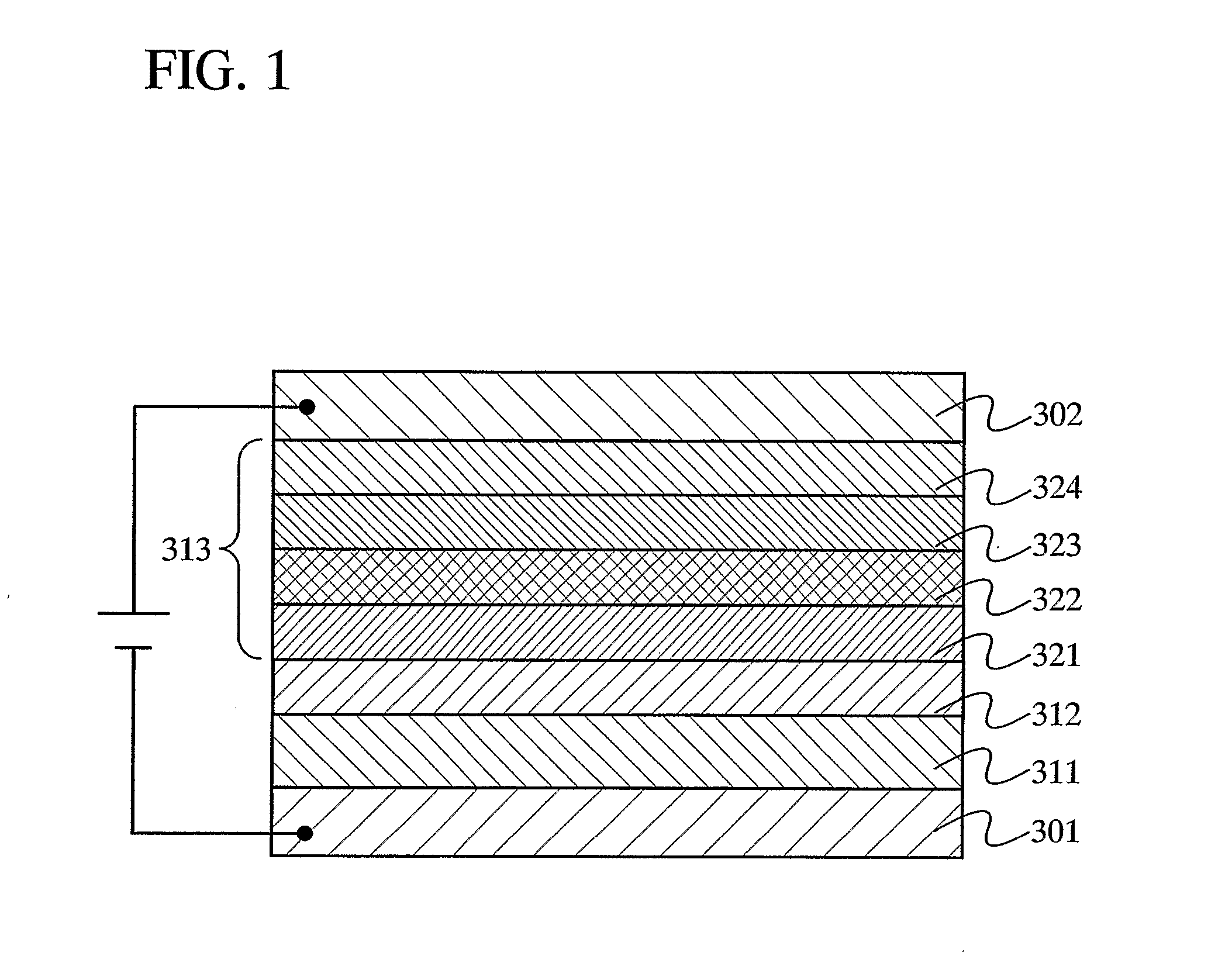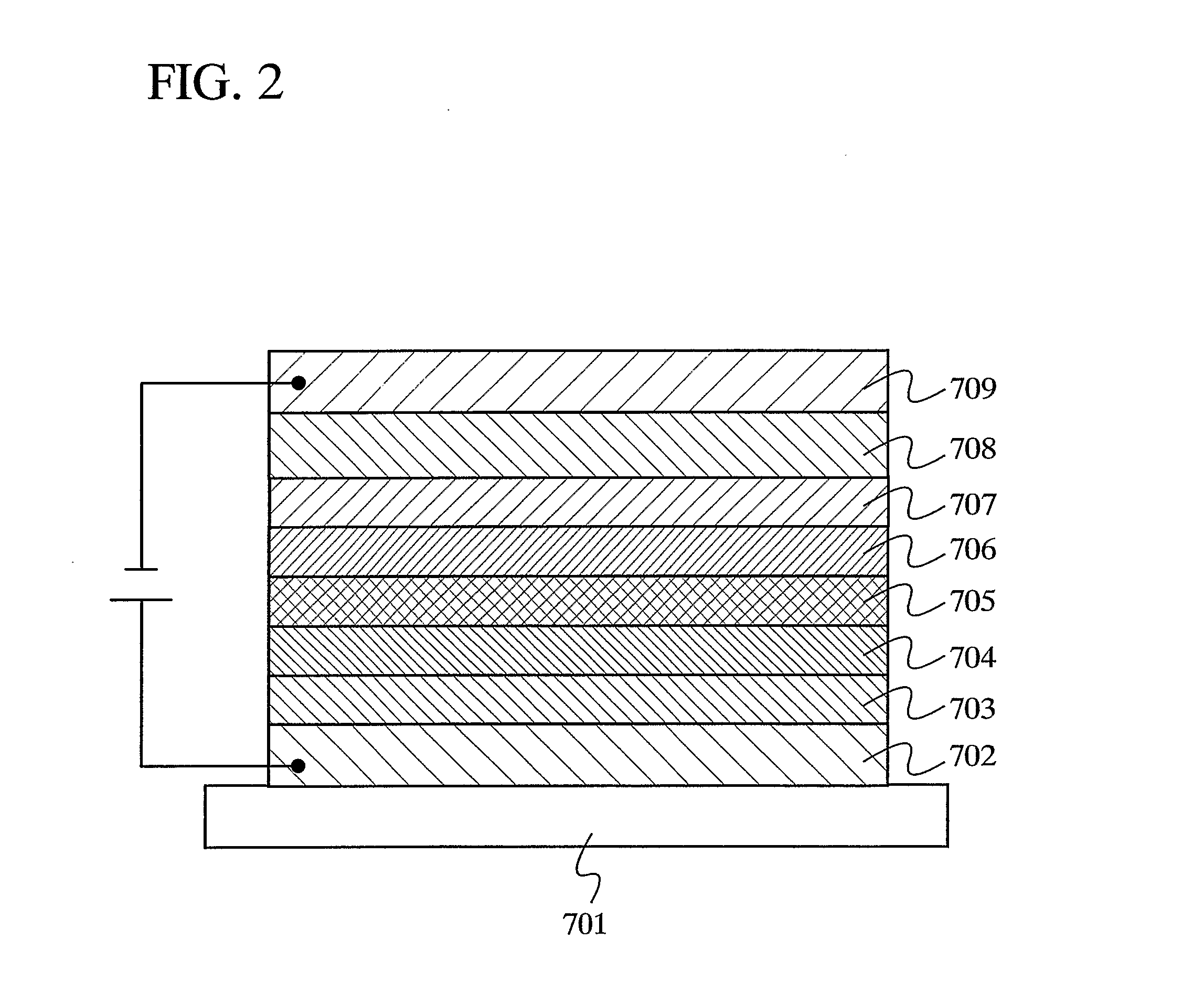Light-emitting element and light emitting device using the same
a technology of light-emitting elements and light-emitting devices, which is applied in the direction of discharge tubes/lamp details, organic semiconductor devices, discharge tubes/lamp details, etc., can solve the problems of increasing the driving voltage with the accumulation of light-emission time, and achieves less increase in resistance value, high reliability, and less increase in driving voltage
- Summary
- Abstract
- Description
- Claims
- Application Information
AI Technical Summary
Benefits of technology
Problems solved by technology
Method used
Image
Examples
embodiment mode 1
[0047] One mode of the present invention will be described with reference to a cross sectional view of a light-emitting element as shown in FIG. 1.
[0048] The light-emitting element includes a first layer 311, a second layer 312 and a third layer 313 between a first electrode 301 and a second electrode 302. The first layer 311, the second layer 312 and the third layer 313 are stacked sequentially. The first layer 311 is in contact with the first electrode 301 and the third layer 313 is in contact with the second electrode 302.
[0049] The light-emitting element of this embodiment mode is operated as follows. When voltage is applied such that a potential of the second electrode 302 is higher than that of the first electrode 301, holes are injected into the first electrode 301 from the first layer 311 while electrons are injected into the third layer 313 from the second layer 312. Also, holes are injected into the third layer 313 from the second electrode 302. The holes injected from t...
embodiment mode 2
[0070] This embodiment mode will describe a light-emitting element in which, by controlling the thickness of a layer generating holes, a light extraction efficiency is increased and an optical distance between an reflecting surface and a light-extraction surface (or a light-emitting region) is controlled to reduce changes in emission spectrum depending on an angle between the light-extraction surface and the viewer's line of sight, with reference to FIG. 24.
[0071] A light-emitting element shown in FIG. 24 comprises a first layer 211 generating holes, a second layer 212 generating electrons, and a third layer 213 containing a light-emitting substance between a first electrode 201 and a second electrode 202. The first layer 211, the second layer 212 and the third layer 213 are stacked sequentially with the second layer 212 interposed between the first and third layers. The first layer 211 is in contact with the first electrode 201 while the third layer 213 is in contact with the seco...
embodiment mode 3
[0087] The light-emitting element of the present invention is a highly reliable element having less increase in the driving voltage with the accumulation of light-emission time. Thus, by applying a light-emitting element of the present invention to, e.g., a pixel portion, a light-emitting device having lower power consumption can be obtained. Also, the light-emitting element of the present invention can prevent a short circuit between electrodes easily. Therefore, by applying a light-emitting element of the present invention to a pixel portion, a light-emitting device capable of displaying favorable images having less defects due to a short circuit can be obtained. Furthermore, the light-emitting element of the present invention can easily increase extraction efficiency of light. By applying a light-emitting element of the present invention to a pixel portion, a light-emitting device capable of performing display operation at low power consumption can be obtained.
[0088] In this emb...
PUM
 Login to View More
Login to View More Abstract
Description
Claims
Application Information
 Login to View More
Login to View More - R&D
- Intellectual Property
- Life Sciences
- Materials
- Tech Scout
- Unparalleled Data Quality
- Higher Quality Content
- 60% Fewer Hallucinations
Browse by: Latest US Patents, China's latest patents, Technical Efficacy Thesaurus, Application Domain, Technology Topic, Popular Technical Reports.
© 2025 PatSnap. All rights reserved.Legal|Privacy policy|Modern Slavery Act Transparency Statement|Sitemap|About US| Contact US: help@patsnap.com



